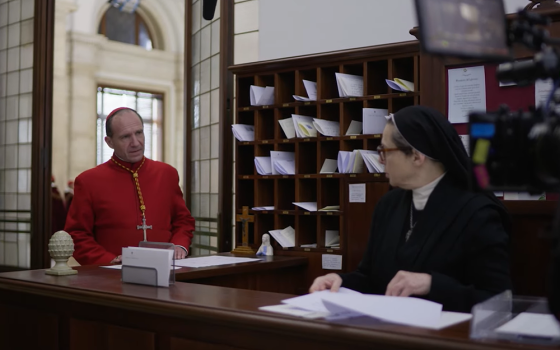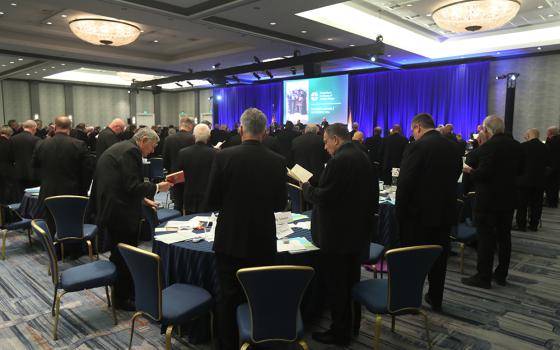
Art by Julie Lonneman
In an Aug. 28, 2018 article, "Death in the Church: Is New Life Ahead?" published on The Omega Center website, Franciscan Sr. and scholar Ilia Delio characterizes much of our practical theology as "mechanical and atomistic." She writes:
Walk into many churches and you will hear God described as a being who behaves almost as predictably as Newton's universe. Say you believe in God and you will be saved. Sin against God and you will be condemned. Say you are sorry and you will be forgiven. Obey the law and you will be blessed.
This perspective nurtures an approach to God that tends to diminish any spontaneity, surprise or unanticipated divine interaction. God is so much bigger, so much grander, loves so much more expansively and cares so much more intimately for each creature than what we dare to imagine. God acts so much more dynamically, unpredictably and affectionately with each of us individually and with the whole unfolding cosmos than we normally tend to recognize. As we enter the Lenten season, I suggest that the immensity, wonder, mystery and extraordinary beauty of the universe and the phenomenal insights of cosmology, astronomy and evolution possess the potential to stretch and deepen our experience of the paschal mystery of Christ.
Some of the great discoveries of our time are the revelations identified by the Hubble telescope. We would never have known either the vast immensity of the universe nor the billions of years when it first began its journey. Perhaps most surprising was in 2017 when the Hubble telescope focused its lens on a diameter of the universe about as large as the opening of a straw and found there in deep space where we had never before gazed 2 trillion galaxies! We are definitely not alone. The Hubble telescope also allowed astronomers to peer back into time and glimpse the initial burst of energy which birthed the universe and astonishingly to be able to assess its estimated age as 14 billion years. The staggering expanse of the universe and the phenomena of deep time over which evolved stars, planets, earth, towering mountains, fragile flowers, rushing waters surging with life, myriads of winged birds, fertile land, an array of vegetation, vivid beauty, manifold and miraculously formed insects and mammals, and finally, the evolution of human consciousness capable of knowing God is to be cast to one's knees in silent adoration. And God is not done yet! How can this not cause us to reconsider our understanding of God, our image of ourselves and our regard for creation? How might these insights expand and deepen our faith in the paschal mystery, our preparation during Lent and our celebration of the Triduum?
We tend to use the word creation as if it was a past event, but it dynamically, relentlessly continues. There is a divine energy hidden within, urging everything forward toward greater beauty, complexity and unity. In Quest for the Living God, St. Joseph Sr. Elizabeth Johnson describes this process:
The ever-faithful God is graciously courteous toward the freedom of the natural order. Rather than intervening from outside, the Creator Spirit enables ongoing creation from within (these spatial metaphors are inadequate) by endowing the universe with the capacity to transcend itself toward ever new forms. Self-organizing, complex systems keep on introducing surprises as the world of chance occurring within law-like structures evolves over eons of deep time. In, with and under these processes, the generous Spirit of God energizes the ongoing creation of the world.
In other words, God is the not a puppeteer pulling strings to cause creation to come into being according to a set plan but rather invites and urges creation forward according to a divine dream all the while reverencing its freedom to respond. The Spirit of God "Over the bent world broods with warm breast and with ah! Bright wings" (Gerard Manley Hopkins. Poems and Prose). The amazing truth is that creation participates with God in its own creation.
When we consider the immensity of the universe and how God set the cosmos on a breathtaking journey, while at each moment God's warm loving energy hovered over every particle and every movement constantly encouraging all toward fullness and union, does it not alter our consciousness of God as only concerned about human beings and heighten our awareness of how much we are an integral part of a gigantic web of life? Nothing exists outside of God's love and the vastness of the universe gives us but a tiny indication of the height and depth, length and breadth of this divine yet welcoming immanent love. When we reflect upon the painfully slow evolutionary process, we realize that God has been at this a very long time. How sacred this process is! All that has been created is imbued with the very life of God. In John Muir Spiritual Writings, we read of Muir's own mystical awareness of God's active presence in everything, "the whole sky and the rocks and flowers are drenched with spiritual life — with God." "Every particle of rock or water or air has God by its side leading it the way it should go. How else would it know where to go or what to do?"
Muir experienced that all creation and every creature, everything is in motion, flowing, always beginning, always being created, always fresh born. He wrote: "From form to form, beauty to beauty, ever-changing, never resting, all are speeding on with love's enthusiasm, singing with the stars the eternal song of creation." In The Unbearable Wholeness of Being, Franciscan Sr. Ilia Delio echoes these sentiments, "The dynamic fountain fullness of divine love means forever the newness of the world; God is ever newness in love, and thus the world is ever new as well. Evolution is an ever newness of life born out of the newness of love."
In contemplating the beginning and on-going wonder of creation we touch both the secret abundance of divine out-pouring love and the terrible smallness of our own being encompassed in such profound mystery.
God's love expressed in on-going creation is unimaginable. Yet the inconceivable event of the Incarnation in which God gazes in wonder through our eyes, touches creation with our skin and experiences suffering from within a vulnerable heart like our own could only be conceived from within an infinite longing that yearns to be one with the beloved. Elizabeth Johnson in her book Creation and the Cross, explores Niels Gregersen's concept of "deep incarnation."
Deep incarnation understands John's gospel to be saying the sarx that the word of God became not only weds Jesus Christ to other human beings in the human species; it also reaches beyond us to join the incarnate one to the whole evolving biological world of living creatures and the cosmic dust of which they are composed.
Evolutionary science gives us a glimpse into the miraculous mystery of the unfolding universe bringing forth assorted and innumerable forms of life, including ourselves. All bear within themselves the elements of the unfathomable matter and energy which burst forth at the origin of the universe. The eternal word of God enters into this developing process and joins to God's own self the evolving matter and energy of the universe in becoming one with us. "And the Word became flesh and made his dwelling among us" (John 1:14). As Johnson notes, "God shares the membrane of life with other creatures, all made from cosmic material, and vulnerable to death and disintegration."
To suggest the Incarnation was simply an afterthought, the result of something gone awry in God's initial plan and the suffering and death of Jesus as only saving us from sin is to narrow God's generous gift and to perceive God's ardent longing for us much weaker than the totality of Scripture proclaims. Furthermore, it does not allow for other biblical interpretations. Salesian Fr. Francis J. Moloney, in his book Love in the Gospel of John, asserts the cross is the quintessential revelation of God's consummate love. The secret to Jesus' words and deeds, Moloney suggests is found in the prologue: "No one has ever seen God. The only Son, God, who is at the Father's side, has revealed him" (John 1:18). Jesus is the visible embodiment of the unseen God. Yet the epitome, the climax, the most intense and intimate revelation of God, Moloney emphasizes, is in Jesus' suffering and death. Here the absolute love of God for the world is embodied in the word flesh. "He loved his own in the world and he loved them to the end" (13:1). He loved them to the end of his temporal existence but more essentially to the end of everything he had to give, all was emptied out. There was nothing else to give. "It is finished!" (19:30). "I am telling you before it happens, so that when it happens you may believe that I AM" (13:19). Jesus suffered and died because he was faithful to his mission to make God known.
It is important to recognize creation was not made complete or whole, and thus the redeeming action of God has been present and on-going from the inception of the universe. The Word-Wisdom as artisan was present at creation's origins playing and finding divine delight when God established the heavens, marked out the face of the deep, made firm the skies, fixed fast the springs of the deep and set the sea its limit (Proverbs 8:27-29). From the beginning, the Christ was already coming into the world. Yet reflecting on the suffering, death and resurrection of Jesus we discern yet more unfathomable expressions of God's love and solidarity with us.
Advertisement
First, the abiding answer God gives to those who are broken-hearted and crushed in spirit is: "I have witnessed the affliction of my people ... and have heard their cry ... I know well what they are suffering. Therefore I have come down to rescue them" (Exodus 3:7-8). In the crucified one, God affirms that God identifies with all who suffer. Johnson presents a theology of the cross as one of accompaniment. She states, "God does not intervene but neither does not God abandon" (Ibid.). There is something in us that longs for a mighty God who intervenes, crushes the oppressor and takes away the ravaging pain. Yet the God who is present in the cross of Jesus is not the God of glory and power but the God of compassion and consolation, the God who accompanies. In the crucified Jesus and in all who suffer, we can truly proclaim, "Here I see God." And God's presence underscores his unyielding promise: "My love shall never fall away from you" (Isaiah 54:10). The profound reality is that God has been affectionately accompanying the universe and every creature that emerged and died from the beginning of time. God has never left us alone.
Second, in the resurrection of Jesus, God's ineffable love so permeates all who die that an extraordinary new way of being, a new way of living occurs. Resurrection is not merely resuscitation. The great hidden secret we have been carrying with us all along, this divine energy that brought us into being and has been pulsing in our inner depths throughout our life's journey, bursts forth in all its fullness. We are in truth divinized. The pledge found in the prologue of John is fulfilled. "The light shines in the darkness, and the darkness has not overcome it" (1:5). God remains faithful and has the last word regarding death. The Resurrection is irrevocable and stands as the unfaltering guarantee of new and eternal life.
Creation is not just an insignificant background on which human redemption is played out, but rather the redeeming act of Christ is integrated into the entire unfolding cosmos. Nothing is excluded from the merciful, redeeming act of God and from the divine promise expressed in the Resurrection. The same divine energy pulsing within the universe from the beginning now brings all to fulfillment in God. "Then I saw a new heaven and a new earth. ... there shall be no more death or mourning, wailing or pain, [for] the old order has passed away. ... Behold, I make all things new" (Revelation 21:1, 4, 5).
When the universe was only 6 billion years young, a gravitational wave birthed from the collision of two gigantic black holes violently shook the surrounding fabric of space and time. This energy wave was 50 times greater than the output of all the stars in the universe. It traveled at the speed of light for almost 8 billion years, and finally reached Earth in 2016 and was recorded in the states of Washington and Louisiana. If a physical collision can cause such a release of enormous energy and can travel through the universe for such billions of years, what must be the energy that God's love releases first in the birthing of the universe and even more in the enormous and consummate outpouring of self given by Jesus on the cross and the unfathomable power and promise of God in raising him from the dead. This gigantic wave of love is so seismic that it reaches back into the beginning of time and forward to its culmination in the fullness of the heart of God. Truly the proclamation of Christ is being fulfilled. "I am the Alpha and the Omega, the beginning and the end" (Revelation 21:6).
Incarnation and the death and resurrection of Jesus, like creation, are not past events. This reality is on-going in the hidden, silent, inner lining of all that is. We celebrate it and touch it in every Eucharist and mark it intensely during the Triduum liturgy. "What is the kingdom of God like? To what can I compare it?" (Luke 13:18). Jesus asks himself. He answers his question with the mustard seed and yeast. The kingdom is within, a hidden, silent presence of divine energy. The seed yields to its dying and the wheat flour to its leavening in order to grab hold of it. We are called to yield to the steady march of triune love bringing all to completion. The creating God is permeating, penetrating every creature, every particle, all being with the very energy of God's own life. The Spirit's breath is constant birthing, enkindling, bringing forth new and more abundant life. The self-emptying love of Jesus the Christ and the mighty power of his resurrection still seeps into the universe, marinates everything, and is making all that is fertile with the dynamic of self-giving love. Franciscan Sr. Pat Farrell in her 2016 address to the Leadership Conference of Religious Women said:
Ninety-five percent of the universe does not reflect light and is therefore eternally invisible, known only by observable effects ... I find that astonishing! ... If ninety-five percent of what holds the universe together is invisible, so also is the dynamic movement of Spirit carrying us toward an unfolding both real and yet unseen. There is so much more going on within and around us than we will ever be able to perceive. The unseen movement of Love is creatively holding everything together in ways infinitely beyond what we could ask or imagine. We are being drawn and led by the allure of Holy Mystery. Divine Presence is at work in all of the complexities, uncertainties and crises swirling around us ... and our messy world.
Triune love continues to work even now. We are not simply passive observers. We are called to become aware, to develop a new consciousness and then to yield, to surrender unresistingly to this relentless, unimaginable love living and moving within us, inviting us to participate in this exquisite dance, bringing everything to oneness and fullness in God. Is not the season of Lent a perfect time to learn the first steps?
Editor's note: This reflection was originally published in the March 2019 issue of Celebration. Sign up to receive daily Lenten reflections.








